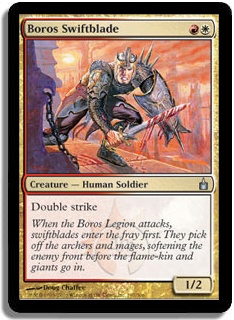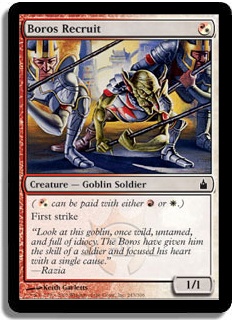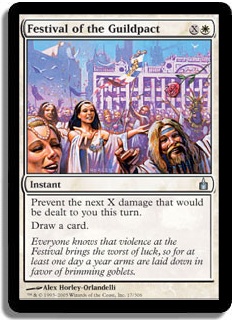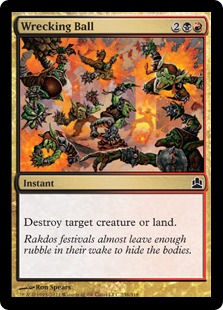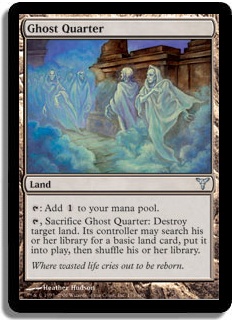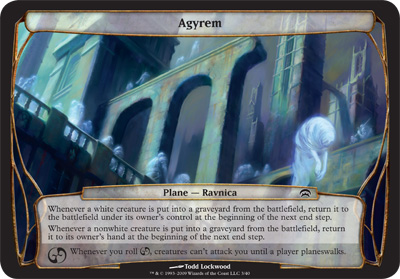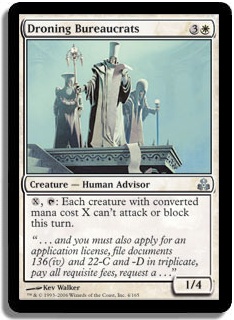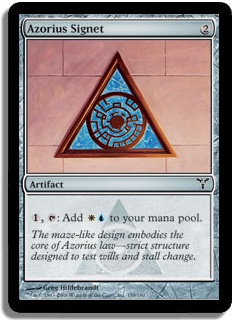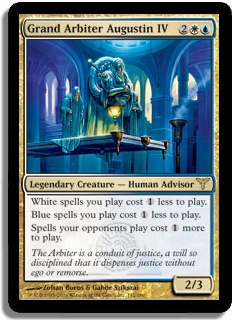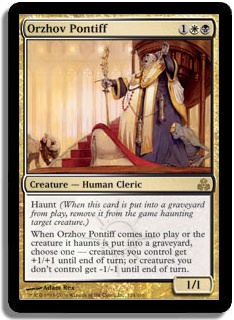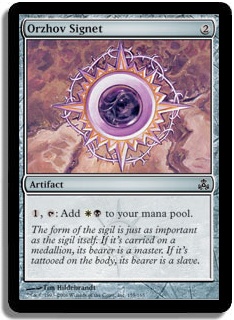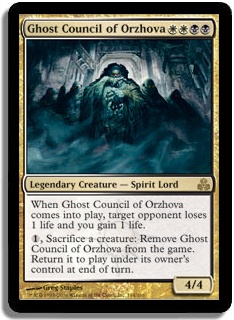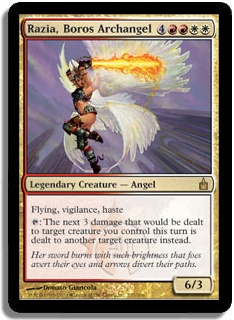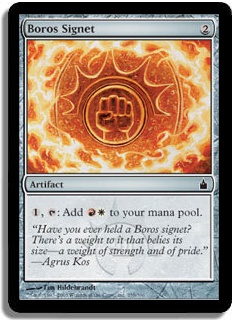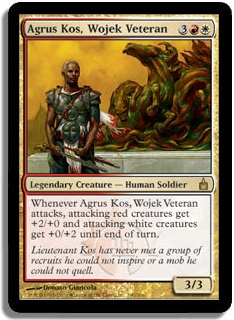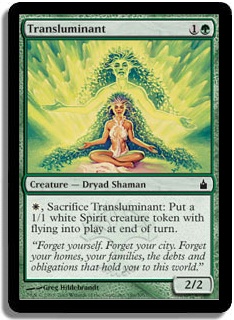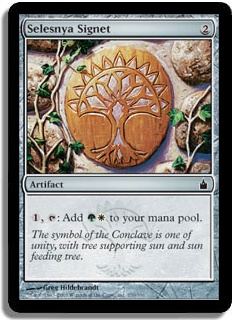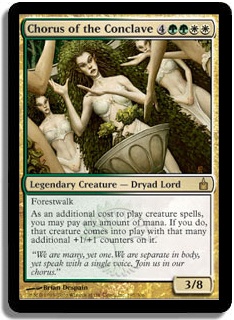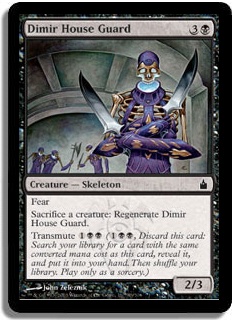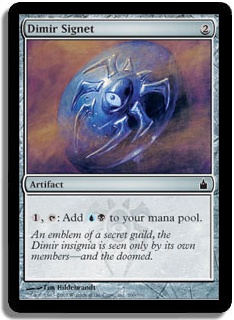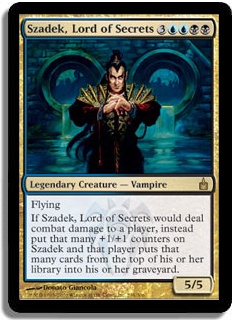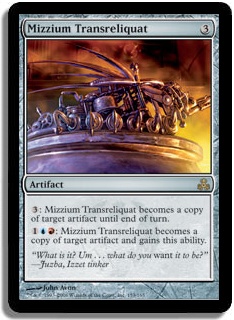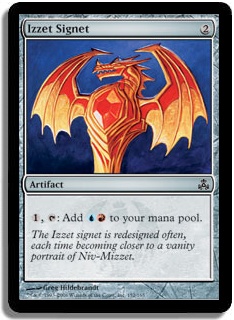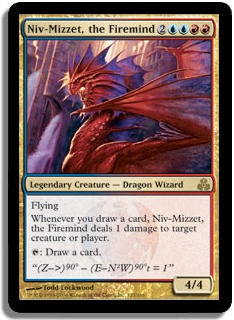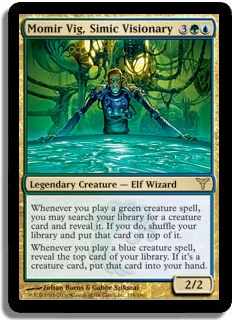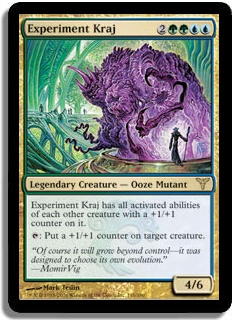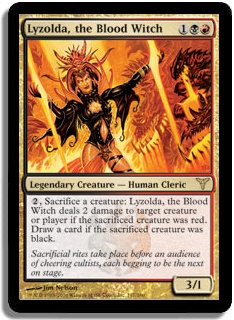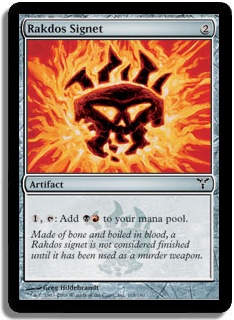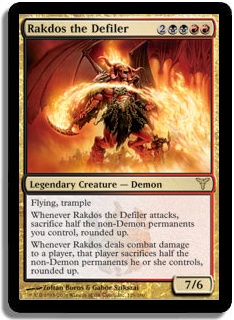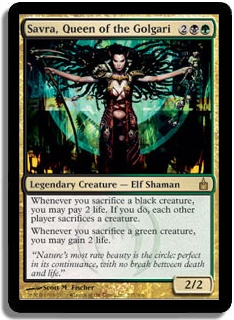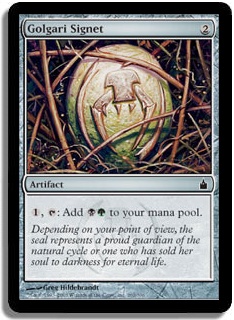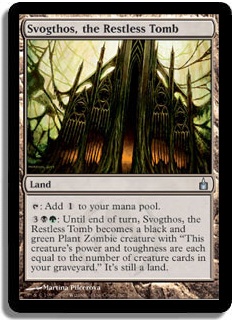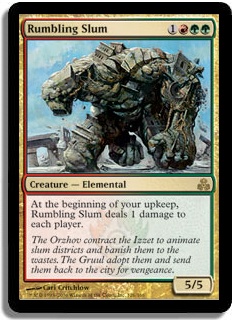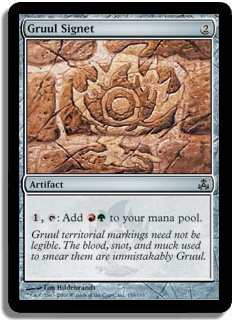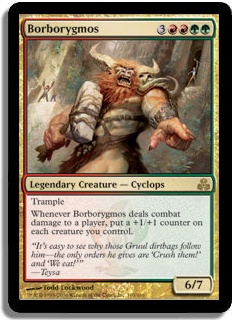[If you haven’t seen it already, please watch the Magic: The Gathering Comic-Con Panel video.]
When the upcoming Magic: The Gathering set was announced as Return to Ravnica, the general reaction was positive. "Ravnica’s back," many celebrated, and I was among them. Not only did Ravnica have wonderful flavor, but it was also a well-made set that balanced the old and the new, bringing back gold cards as a theme for the first time since Invasion block as well as introducing the hybrid mana costs that saw a reprise in Shadowmoor block.
As with the Mirrodin / Scars of Mirrodin pairing before it, seven years’ worth of sets will have passed between Ravnica: City of Guilds and Return to Ravnica. Seven years is a big chunk of time on any non-Nicol Bolas scale. It’s more than one-third of Magic’s tenure so far, and in that time the game has lost mana burn and damage on the stack, gained mythic rares and the planeswalker card type,* and gone through at least two major phases of new player acquisition: the "Assume the Acquisition" and Duels of the Planeswalkers eras (the latter ongoing).
What does "Return to Ravnica" mean to those who’ve never been?
That’s where I come in. Whether you’re a Ravnica long-timer who remembers sitting down for a meal at Pivlichino’s or a newcomer who’d get mugged by a Tin Street Hooligan without me, I’ll be your Civic Wayfinder as Magic prepares to Return to Ravnica. To the market square we go!
The Plane
The city of Ravnica started out merely as the biggest metropolis on its plane, but over the millennia the plane went all-city, all the time—an ecumenopolis, if you like your words National Spelling Bee hard. (By contrast, Earth’s Ravnicas are tiny villages in Slovenia. One has a little over 200 people, the other not quite two dozen.)
Slovenia is in Eastern Europe, and the Ravnica setting is a U.S.A. take on fantasy with an Eastern European or Slavic twist. Most guild and character names are designed to evoke American impressions of "old-world" Eastern Europe. In Slovenian, "ravnica" means "plain" in the geographic sense, and "ravnic" means "plains" in the sense of the Magic card Plains. The architecture takes its cue from Eastern Europe as well; think a soaring cathedral in Prague (Czech Republic) or Warsaw (Poland). If the singing competition The Voice went off-planet and started up The Voice of Ravnica, it’d resemble this (and yes, Ravnican karaoke dreamers would be singing Adele, too).
The usual Magic: The Gathering technology caveats apply to Ravnica. Guns are out, though not mana-battery weapons, and magic solves everything, including the big question of a city-plane: how to feed the masses without any space for farms (there’s a guild for that). Civilization in Ravnica is ancient; at the start of the last Ravnica block, it had been 10,000 years since the prevailing law of the plane, the Guildpact, had gone into effect, and a big party called the Decamillennial celebration was about to happen. Then the plane went mad.
The Guildpact, Then and Now (?)
The original Guildpact was a plane-spanning spell that laid down the roles and responsibilities of the various guilds to each other. At the signing of the Guildpact 10,000 years before the start of Ravnica, the paruns, or leaders of each of the ten guilds, agreed to the magical pact drawn up by a law-and-order mage who later lent his name to the Azorius Senate, the white-blue guild. Naturally, after ten millennia, every guild that was so inclined found plenty of loopholes in the Guildpact, but the long-tenured document served until it was broken by guildmaster-on-guildmaster violence, as expressed in the Ravnica novel cycle.
A new Guildpact was signed a little over two decades after the dissolution of the old one. One of the signatories of the old Guildpact, the dragon Niv-Mizzet, lived to sign the new Guildpact on behalf of the Izzet League, the blue-red guild. Rakdos, demonic head of his namesake cult (the black-red guild), remains on the plane, though he last was seen "chilling" in a lava pit. A couple of other old-Guildpact signers, Svogthir of the black-green Golgari Swarm and Szadek, Lord of Secrets for blue-black House Dimir, were around (if not necessarily in control) for the beginning of the events of the first Ravnica block but either didn’t live to see the end of the story cycle (Szadek) or are of unknown status (Svogthir).
The world of Ravnica changed radically over the course of the block’s storyline. The guilds no longer have the absolute power they once enjoyed with the rise of the Infinite Consortium, yet the guild structure has been emphasized in the marketing for Return to Ravnica. Whatever may have happened in Agents of Artifice has been hand-waved with, "Yeah, guilds are back." The plane of Ravnica, too, has undergone changes; many guild buildings were destroyed in the chaos, and the original Ghost Quarter is now the district of Agyrem.
The Guilds
These will be quick takes on each of the ten guilds, what they were and what they might be.
Azorius Senate (White-Blue)
In two words, "control freaks." They are the courts, they are the law, and unlike you, they as a whole have all the time in the world. They (or rather their then-leader, Grand Arbiter Augustin IV) had a plot to take over Ravnica, a feature the Azorius share with every other blue guild. Not content with the Guildpact, Grand Arbiter Augustin IV had the head of House Dimir—Szadek, Lord of Secrets—destroyed while in Azorius custody after the Dimir plot to take over Ravnica. It’ll be interesting to see how the Azorius and their new guildmaster adjust to the new Ravnica.
Orzhov Syndicate (White-Black)
In two words, "corrupt religion." Thieves and creeps, the top Orzhov wear the "bling of evil," made on the backs of those who have no choice but to believe the Orzhov and their false message. The Church of Deals has power and the will to abuse it. If there’s a way to steal from the flock, the Orzhov have found it, and they’re headed up by a Ghost Council of Orzhova that didn’t find enough time to fleece the masses while alive, so they’re continuing the Syndicate’s work while dead.
Boros Legion (White-Red)
In two words, "law enforcement." The action side of the law, the Boros Legion moves quickly enough to catch lawbreakers, unlike the Azorius Senate. The Boros aren’t merely the cops of Ravnica; they’re also the army of the plane, balancing the discipline and the passion needed to fight evildoers and win. The Ravnica book cycle focused on Lieutenant Agrus Kos, a century-old human Boros police officer with some features straight out of hardboiled noir fiction such as his drinking problem, his ex-wife, and his loathing of rookies and some features unique to Magic’s fantasy, such as his abuse of healing-magic crystals called "teardrops." The first book, titled simply Ravnica, is the best of the three novels in the cycle.**
Selesnya Conclave (White-Green)
In two words, "hippie cult." They put the emphasis on "order" in "natural order," assigning a purpose to anything and everything within their reach. The most evangelical of the guilds, they’re constantly searching for new members. To believers, the Selesnya way is the only truth; to outsiders, that sounds an awful lot like brainwashing. The Selesnya believe in numbers, and their guildmasters have not been single personages but collections of one sort or another.
House Dimir (Blue-Black)
In two words, "secret treachery." At the time of the Decamillennial celebrations, many Ravnicans would have insisted that there were only nine guilds, not ten—that’s how well House Dimir did in convincing the masses of the plane that it didn’t exist. Higher-ups in the other guilds, having dealt with the constant secrets and lies of the guild including the use of worm-like consuming shapeshifters, had no such delusions. Szadek, Lord of Secrets saw his plot to destroy the Selesnya leadership come back around on him (remember, blue equals a plot to take over the plane), leading to his arrest by Agrus Kos of the Boros Legion and his imprisonment and demise with the Azorius Senate.
Izzet League (Blue-Red)
In two words, "mad scientists." They come up with the inventions that make Ravnica run—or not run, if one of their many experiments fails. Led by Niv-Mizzet, a dragon who is only a few thousand years younger than Nicol Bolas and nearly as knowledgeable, the Izzet can be entirely too proud of themselves and their creations; in his passionate arrogance, an Izzet magelord attempted to wake dragons from long-dormant eggs so they could burn down Ravnica and he could rebuild the city-plane as he wanted. (Once again, blue tries to take over the plane.)
Simic Combine (Blue-Green)
In two words, "biological experimenters." Forever seeking to improve on the nature that rapidly dwindled away with the encroachment of the city on the wilds, the Simic are the designated healers of Ravnica, and their cytoplast magic can not only heal but can replace missing body parts such as a hand. The Simic aren’t all happiness, though; as a blue-aligned guild, their former guildmaster—Momir Vig, Simic Visionary—unleashed Experiment Kraj as an attempt to…say it with me…wreck Ravnica and rebuild from the ashes. The new guildmaster of the Simic is a Merfolk, which gets an "interesting" out of me, as there weren’t any Merfolk in the last Ravnica set. (Of course, 2005-2006 was during Merfolk Exile. Times have changed!)
Cult of Rakdos (Black-Red)
In two words, "death cultists." One of the quirky features of the original Guildpact (by Earth standards) is that murder is not illegal, as long as it follows certain rules. "Getting Away with Murder" is written right into Ravnican law, so the demon Rakdos and his cult stay solvent by supplying assassins, magical suicide bombers, and other nastiness to other guilds who don’t want to dirty their hands directly. Sadistic pleasure-cults fueled by ritual sacrifice have pretty high operating expenses, or so I’ve heard.
Golgari Swarm (Black-Green)
In two words, "lifecycle manipulators." Commanders of the powers of life and death, they feed the masses of Ravnica through their growth magic (though the produce from a Golgari Rot Farm is one step up from Soylent Green, if that), but they also find the living, make them dead, and make them undead when it suits them. The first appearance of new guildmaster Jarad was when he was hunting down an ancient centaur and doing exactly that.
Jarad is the most recent of several guildmasters for the Golgari, with predecessors including founder Svogthir, gorgons the Sisters of Stone Death, and Jarad’s necromancer sister Savra. Unusually for a guildmaster (or any Magic character, for that matter), Jarad is identified as an (ex-)husband and father*** by the end of the Ravnica novel cycle; while rescuing his child, Jarad died, but he stuffed his spirit back into his corpse while dead, making him not only a Golgari lich lord but the obvious Ravnica counterpoint to Chuck Norris and his Facts.
Gruul Clans (Red-Green)
In two words, "nature, robbed." When the original Guildpact was written, there were wild areas on the plane still, and these were the responsibility of the passionate nature-lovers known as the Gruul Clans. As the city took over the plane, however, the Gruul were dispossessed of their role one building at a time, and the "nature" aspects of their charge taken over by the other green-aligned guilds. Much as Esper from Alara was bereft of red and green mana, the city-plane of Ravnica has little use for nature that cannot be made to work for the city.
The clans are scattered now, the largest led then and now by a charismatic simpleton of a cyclops named Borborygmos, and they stick to the thinly populated areas and ruined slums of the plane, seething with anger and dreaming of a place of their own. The new guild symbol for the Gruul in Return to Ravnica is far clearer than the old, so the Gruul just might have succeeded. Time will tell.
Last Notes
Gideon Jura last was seen heading to Ravnica to consult with individuals on that plane as to how to handle the ghostly world-destroying Eldrazi. Ravnica has a recent history of dealing with ancient abominations, the Nephilim such as Yore-Tiller Nephilim; will Gideon pick up any useful tricks? Also, Jace has been spotted in the company of Niv-Mizzet, and he last was seen running the Infinite Consortium’s Ravnica operations. Will they meet? Is it possible that the demon Rakdos was in on the Liliana Vess deal, and if so, will she be visiting the plane too?
—
I hope you’ve enjoyed this look back at Ravnica as Magic has known it, and I hope you’re better prepared for the flavor of Ravnica when the plane makes its return.
This is my last chance to go highbrow with this article, so have some opera. Maria Callas is a famous operatic diva, and her signature aria is "Vissi d’arte" from Tosca. Her Act II of Tosca with Tito Gobbi, televised live from Covent Garden, is legendary. Here’s the full performance.
As always, thanks for reading.
— JDB
@jdbeety on Twitter
* Tribal too, technically, but there are no Standard-legal tribal cards, and barring a surprise twist in Return to Ravnica’s mechanics, the card type won’t have any bearing on the new set.
** If you’ve read China Mieville’s The City & the City, the first Ravnica novel predates it by a few years; they share the "detective noir meets speculative fiction" genre premise, but the Ravnica novel has much more fun and much less Marxist political theory from the author.
*** If the story of Agrus Kos comes from noir fiction, Jarad vod Savo and Fonn Zunich are more like Kramer vs. Kramer. He’s an elf bounty hunter and necromancer turned Golgari guildmaster; she’s a half-elf Selesnya bodyguard who was the child of a human Boros police officer and an elf Selesnya priestess. Jarad and Fonn married and had a "three-quarters-elf" son, Myc, but their marriage ended in divorce. They shared custody, with Myc spending part of his time with the Selesnya and part of the time with the Golgari. Myc’s childhood would’ve been messed up even if he hadn’t been kidnapped by a Rakdos priestess for a crazy cult ritual that required a "guildmaster’s blood." Inter-guild love and marriage: it’s complicated.

